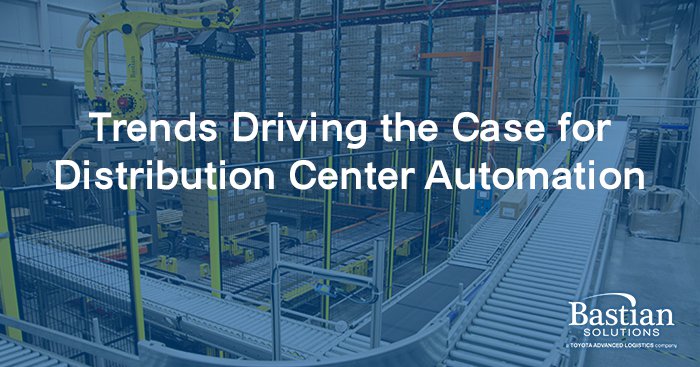
Trends Driving the Case for Distribution Center Automation
Mike Senuta | 31 January 2019
Several concurrent, related economic and technological trends are driving strong demand for distribution center automation and mechanization. This demand is based on both a compelling need to adapt to meet changing business requirements, and an increasingly favorable return on investment for automated systems.
Factors Contributing to Distribution Center Automation
- Low unemployment and intense competition for labor is making it increasingly difficult to recruit and retain distribution center (DC) workers.
- Rising DC labor wage rates are the inevitable result of a tight labor market. Market forces, minimum wage increases, and big companies with increasingly large labor needs have all combined to drive wages higher.
- Several years of having a strong and growing economy means distribution networks are having to expand inventory storage and order throughput capacity.
- The e-commerce revolution and ongoing changes to distribution channels and order profiles – more e-com, multi-channel, omni-channel – means old DC layouts, processes and equipment may not be able to support current and future needs.
- A broad and growing range of automation technologies are now readily available, proven, and cost-effective.
The result is a heightened sense of urgency and a strong business case for modernizing outdated distribution center designs and adopting automation technology. The case for doing so is often a matter of both ROI and business imperative - it may no longer be possible to meet today’s objectives and support tomorrow’s strategic goals with systems designed for yesterday’s challenges.
Business Imperatives to Automate
- The impact of staffing shortfalls on the ability to execute, especially for operations with large peak labor needs competing with other companies for the same labor pool
- Increased need for new DC designs and systems to support changing distribution channels and order profiles as well as higher throughput requirements
- Increased need for shorter order cycle times, higher pick accuracy and fill rates
- Additional DC capacity required to handle future sales growth
- The competition is automating
Distribution Center Automation Return on Investment
- Rising wages = more cost per headcount
- Increasing availability and affordability of automated systems
- More capacity = less need to invest in more and/or larger facilities
- More profitable investment in new technology vs. expanding existing, less efficient systems
- Enable future profits through cost-effective, scalable capacity to support growth
- Reap benefits of lower operating expenses and operational flexibility when the business cycle inevitably turns and the economy slows
Understanding the available technology, including solutions that did not exist just a few years ago, analyzing and modeling order profiles and inventory projections, and determining the optimal technology and design for a given DC application, can be a very complex process. To do so effectively is beyond the capabilities of most companies.
In addition, the transition from a conventional to an automated environment can seem overwhelming. It’s also not without risk. Concerns about the implementation process, go-live execution, transitional and on-going risks, IT implications, and change management are all legitimate - and all can be overcome with the right planning and the right partners.
Confronting these challenges, optimizing complex alternatives, and implementing effectively and on schedule requires consulting and system integration partners with proven capabilities and resources. While there is risk in transitioning to new technologies and operating models, there is greater risk in continuing to struggle to meet business needs with scarce labor and outdated technology and in foregoing the strong ROI for automation while the competition increasingly adopts it.
Choosing partners wisely is critical to navigating the risks and leveraging this pivotal opportunity to transform the operation. Contact us to learn more.
Mike Senuta is a Senior Consulting Engineer with Bastian Solutions, based in Indianapolis. In this role, he works with customers across North America to come up with innovative solutions to a broad range of distribution and material handling challenges. Mike has extensive experience in DC engineering and operations.
Comments
No comments have been posted to this Blog Post
Leave a Reply
Your email address will not be published.
Comment
Thank you for your comment.